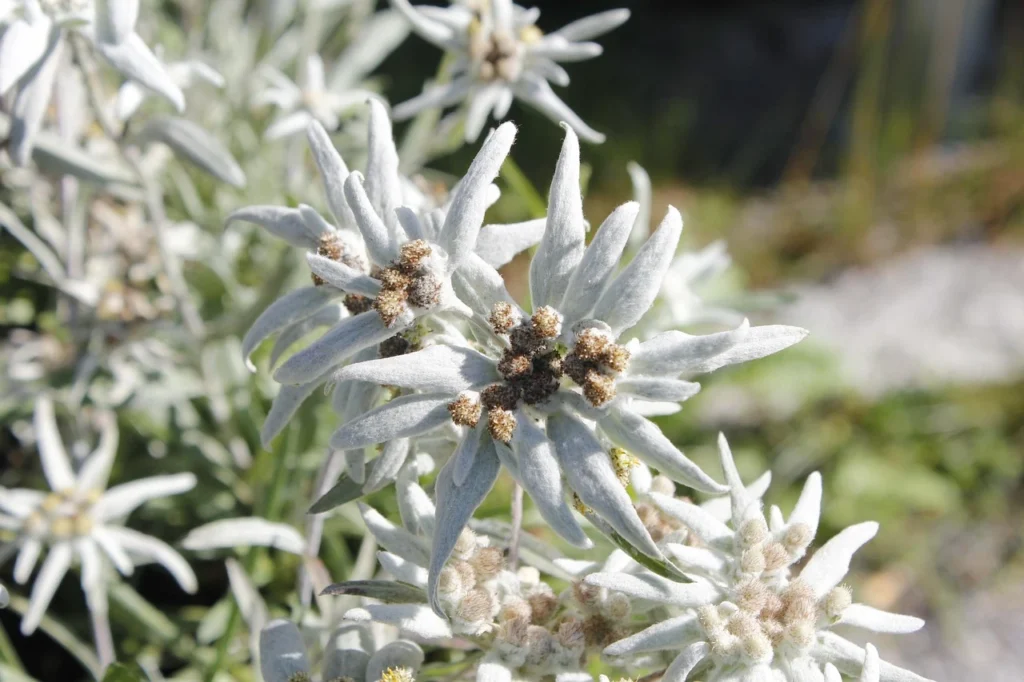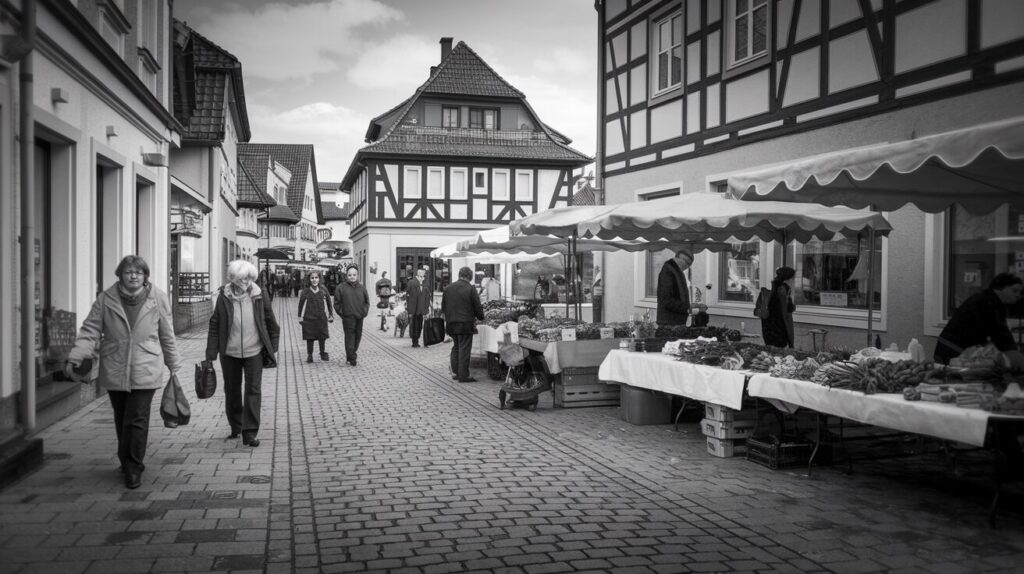A Symbol of Love, Courage and Alpine Beauty
Let’s talk about the Edelweiss flower – that iconic little white flower that seems to pop up everywhere, especially if you have any German heritage like myself. But trust me, there’s way more to this flower than just its good looks. It has a story that’s as tough and interesting as the mountains it calls home.
Believe it or not, the Edelweiss’s story starts way back in Central Asia. Scientists think it started out on those wide-open steppes, slowly evolving over thousands of years to handle some seriously harsh conditions. As the Ice Age chilled out, the Edelweiss flower made its way westward, eventually settling down in the European Alps. And that’s how it became the super-resilient flower we know and love today!
Now, the name “Edelweiss” itself is a total giveaway to its German roots. It basically means “noble white,” which is a pretty perfect description, right? But here’s a fun fact: it has tons of different names depending on where you are in the Alps. For example, the Italians call it “stella alpina” (alpine star), and the French call it “étoile des neiges” (star of the snows). It just goes to show how widespread and loved this flower is!
People started really noticing the Edelweiss flower back in the 1700s, with the scientists getting curious about how it managed to survive in such a tough environment. But it wasn’t until the 1800s that it really took off as a cultural icon, becoming a symbol of everything from romance to bravery to good ol’ national pride.
Where Does This Mountain Flower Like to Grow?
When you picture the Edelweiss, you probably think of those stunning, snow-covered Alps, right? Well, that’s exactly where it thrives! This tough little flower loves clinging to rocky slopes and ridges at super high altitudes – we’re talking anywhere from 5,900 to 9,800 feet!
You can find it growing wild in Germany, Austria, Switzerland, Italy, France, and Slovenia. It’s usually growing in soil that’s rich in limestone and in spots that are nice and sunny with good drainage. The Edelweiss can handle extreme temperatures, strong winds, and intense sunlight.
Those fuzzy, white “petals” you see aren’t actually petals at all. They’re called bracts, and they’re basically modified leaves that surround the real, tiny flowers. These bracts are super important because they act like a cozy blanket, protecting the plant from frost and helping it hold onto water. They also reflect sunlight, so the plant doesn’t get scorched in that intense mountain sun.
These days, you can even find Edelweiss growing in gardens and nurseries. That way, people can enjoy its beauty without picking it from the wild. But fair warning: growing Edelweiss can be a bit tricky! It needs the right kind of soil and really good drainage.



Why Do We Love the Edelweiss So Much?
Wo why is the Edelweiss so popular? Well, it’s all about what it represents.
- Purity and Beauty: That pure white color and delicate look just represents “innocence” and “untouched beauty.” And because it grows in the pristine Alps, it’s seen as a symbol of unspoiled nature.
- Courage and Bravery: Since it grows in such remote and hard-to-reach places, the Edelweiss has become a symbol of courage and daring. There’s even a legend that young guys would risk their necks to pick one for their sweethearts to prove how much they loved them. Talk about dedication!
- National Pride: In a lot of Alpine countries, the Edelweiss is a big symbol of national identity. It represents the tough spirit of the mountain people and their deep connection to the land. You’ll see it on coins, stamps, and all sorts of emblems. It’s a visual reminder of their heritage.
- Romance: Last but not least, the Edelweiss flower is all about love and devotion. Like I said before, risking life and limb to get one for your loved one was seen as the ultimate romantic gesture. That’s why it shows up in so many songs, poems, and stories.
So, there you have it! The Edelweiss is a beautiful flower with a fascinating history and a whole lot of meaning. Next time you see one, remember that it’s more than just a pretty face – it’s a symbol of everything from courage to love to the rugged spirit of the mountains.
Why Men Wear It: The Edelweiss Flower is a Badge of Honor
So, have you ever wondered why you see that little white flower, the edelweiss, pinned on hats or lapels, especially around German cultural events? It’s more than just a pretty bloom – it’s a story wrapped in petals! The tradition of men wearing the edelweiss goes way back to the 1800s, and it’s evolved into something really special. It started as a symbol of true love, kind of like a guy proving he’d go to the ends of the earth (or, well, the top of a mountain!) for his sweetheart. But it became so much more!
Think about it:
- Proof of Bravery: Remember how tough it was to get to those edelweiss flowers way up in the alps? Wearing one was like saying, “Hey, I’m tough! I can handle a challenge!” It showed you had guts and skill.
- A Nod to Our Alpine Roots: The edelweiss became a symbol of the mountain folk and their unique way of life. Wearing it was like saying, “I’m connected to the Alps, to the traditions, to the Heimat.”
- The Military Connection: During the World Wars, the edelweiss was adopted by mountain troops. It stood for their toughness, their ability to adapt, and their dedication. It was a badge of honor, a symbol of unity or “we’re all in this together.”
- A Touch of Style: Let’s be honest, the edelweiss just looks good! It became a popular accessory on hats, jackets, and Trachten (traditional clothing). It’s a nice way to show your connection to the Alps.
Today, you’ll still see folks wearing the edelweiss flower, including men as well as women. Often as a brooch or pin, it’s a subtle but powerful way to show pride in our German (or other Alpine) heritage. It’s like a little secret handshake that says, “I get it. I understand.”



The Edelweiss Today: An Enduring Legacy
The edelweiss still means a lot today. It’s a reminder of our heritage, the courage of our ancestors, and the sheer beauty of the natural world. You see it everywhere, from tourist shops to official emblems, which just goes to show how deeply it’s ingrained in the culture.
For us German-Americans, the edelweiss flower is a tangible link to the alte Heimat. It brings back memories of family traditions, the values we were raised with, and the stories our grandparents told us. Just seeing one can spark a wave of nostalgia and a deep sense of connection. It’s like a little piece of Germany right here with us.
But beyond all that, the edelweiss flower also reminds us to take care of the environment. Those delicate alpine ecosystems are under threat, and protecting the edelweiss means protecting its home.
When we understand the history and the meaning of the edelweiss, we appreciate it even more. It’s a symbol that goes beyond borders and generations. It reminds us of the power of nature, the importance of bravery, and the enduring bonds of family and heritage.
Conclusion: Embrace the Edelweiss Spirit
The edelweiss is more than just a flower; it’s a symbol of strength, love, and connection to our Alpine roots. For German-Americans or anyone that appreciates German culture, it’s a powerful reminder of who we are and where we come from.
So, whether you wear it proudly, plant it in your garden, or simply admire its beauty, let the edelweiss inspire you. Let it remind you of our heritage, the beauty of the world around us, and the courage we all have inside. Embrace the edelweiss spirit!



FAQ
I’ve heard the Edelweiss is a very special flower in German culture. What exactly does it symbolize?
The Edelweiss flower holds a very special place in German and Austrian culture. It traditionally symbolizes purity, courage, and devotion. Because it grows in such difficult, high-altitude environments, it represents overcoming challenges and demonstrating bravery. It’s often associated with love, loyalty, and the rugged beauty of the Alps. For many German-Americans, it’s a beautiful reminder of their heritage and the strength of their ancestors.
Where does the Edelweiss flower actually grow? I’ve always pictured it high in the Alps!
You’re absolutely right! The Edelweiss is primarily found in the high-altitude regions of the Alps, typically between 5,900 and 9,800 feet. While it’s most strongly associated with the Alps (especially in Austria, Switzerland, and Germany), it can also be found in other mountainous regions of Europe and even parts of Asia. So, while your mental image of it nestled in the Alps is spot-on, its range is a little wider than just that!
Is it legal to pick Edelweiss flowers if I ever come across them in the mountains?
In many areas where Edelweiss grows, it’s actually a protected species. Picking the flowers is often prohibited to help preserve their population. Before you even think about picking one, be sure to check the local regulations and laws of the specific region you’re in. It’s always best to admire them in their natural habitat and leave them for others to enjoy. Taking pictures is a great way to preserve the memory without harming the environment!
My Oma used to tell me stories about the Edelweiss. Does it have a rich history or folklore associated with it?
Absolutely! The Edelweiss is steeped in history and folklore. It’s been featured in countless songs, poems, and stories throughout German and Austrian culture. Historically, young men would risk their lives to pick Edelweiss flowers as a token of love for their sweethearts, proving their courage and devotion. Its association with bravery and purity has made it a powerful symbol for generations. Your Oma’s stories are likely part of a long and beautiful tradition!
Can I grow Edelweiss in my own garden here in the United States? What kind of conditions does it need?
Yes, you can! While it can be a bit challenging, Edelweiss can be grown in gardens outside of its native alpine environment. It needs well-drained, slightly alkaline soil and plenty of sunlight. Think about mimicking its natural habitat: rocky, high-altitude conditions. It’s also important to avoid overwatering. Look for Edelweiss seeds or seedlings at nurseries that specialize in alpine or rock garden plants. With a little care and attention, you can enjoy this beautiful symbol of your heritage right in your own backyard!
*You may also like: Hidden German Festivals and Celebrations




